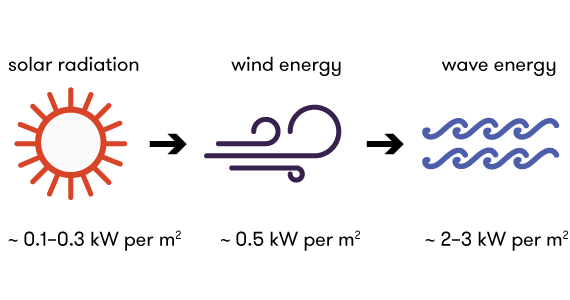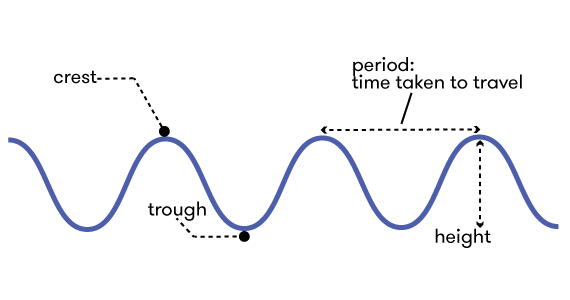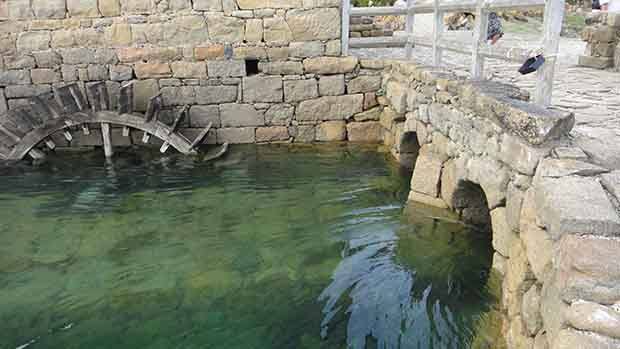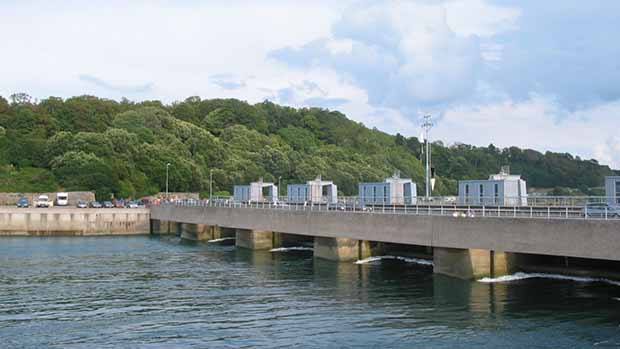Harnessing the power of the ocean
Expert reviewers
Essentials
- The ocean contains an enormous amount of energy that we have only recently started to harness.
- Wave power technology takes advantage of ocean swells generated by strong winds.
- Tidal power technology harnesses the energy in the movement of the tides, which are a result of the combined gravitational effects of the moon and the sun.
- Ocean power is not yet widely deployed globally, but is a growing market with research underway in several countries, including Australia, Canada, the USA and the UK.
There is an enormous amount of energy contained within the sea—just think of those waves, relentlessly pounding on the beaches, and the movement of the tides that see vast volumes of water rise and fall twice a day. Imagine if we could harness that energy to power our homes and cities?
What we need is a way to convert the ocean's kinetic energy—the energy of motion—into electricity. To do so, we need to understand the two main types of energy that can be derived from the ocean: wave and tidal energy.
What is wave energy?
Imagine you’re standing in front of a very still pond, and you threw a small stone in. As soon as the stone hits the surface of the water, small ripples move out in all directions. There are a few characteristics of the ripples that you could measure, like the distance they travel from the source before dissipating, and the size or height of each ripple.
This works in much the same way in the ocean, except instead of rocks or stones, it is wind energy that generates the ripples, and they’re generated on a much grander scale, as waves. As wind blows across the surface of the ocean, the molecules of air hit the water molecules at high speeds, causing friction. The friction pushes the water molecules into other water molecules, and this motion is what forms waves. While the size of waves is influenced by water depth, sea floor topography and water density, it is largely determined by wind speed and duration, as the energy of the wind is transferred into the waves.
Ultimately, it is solar energy that starts the process, as it is differences in air temperature that cause wind. The energy that is transferred as solar radiation from the sun to the wind, and finally to waves in the ocean becomes concentrated at each step of the process. This is what makes wave energy such a good potential energy source.

The height of a wave is an important factor in determining how much energy a wave contains. A wave’s height is the difference between its highest point (the crest), and its lowest point (the trough). Another feature that contributes to wave energy is the wave period—how long, in seconds, it takes for one wave crest to travel the distance between two wave crests. The greater the wave height, and the shorter the period, the more energy it contains.
Waves travel through the ocean in groups, and individual waves appear to move through this group, from the back of the group to the front, where they dissipate. So, the energy waves contain depends on the group velocity of the collection of waves, rather than on the individual wave’s velocity. In deep water, the group velocity is half the velocity of an individual wave within the group. In shallow water, the group velocity and an individual wave’s velocity are the same.

Wave energy comprises both choppy waves beaten up by the wind, and long-period waves, also known as swell, that are formed by the energy of strong oceanic storms, and can travel hundreds of kilometres. Choppy waves, which rise and calm quickly with weather conditions, are not suitable for electricity generation. They are shallow and variable, and their energy is low. By contrast, ocean swells are made up of persistently powerful and regular waves from which it's relatively easier to extract energy.
How do we harness wave energy?
There are many ways of classifying the various types of technology used to convert wave energy to electricity. For simplicity, they can be divided into three main types: oscillating water columns, oscillating bodies and overtopping convertors.
Oscillating water columns
Oscillating water columns use wave surges to drive a stream of trapped air through an air turbine. These devices are essentially large hollow columns half submerged in the ocean, with an underwater vent open to the sea. The movement of waves pushes water into the chamber, forcing air through the column. As waves recede, air is sucked back through the column in the other direction.
The movement of air rotates a turbine in the column, which rapidly turns a generator to produce electricity. The turbines in oscillating water columns are specially designed to turn in the same direction irrespective of the direction of the air movement, which takes advantage of the back-and-forth movement of air.
Oscillating bodies
Oscillating bodies use floating buoys or platforms that rise and fall with the swell. There is no one standard for this type of technology, and they appear in many forms.
The most common oscillating bodies are called point absorber buoys. They are fixed to the sea floor via a hydraulic pump. The buoy moves up and down along ocean swell crests and troughs, activating the hydraulic pump which pushes water or air through a turbine, which in turn rotates a generator to produce electricity.
Another commonly used wave power generator is a surface attenuator. This is a series of long floating cylindrical sections, connected by hinges, that are arranged perpendicular to oncoming waves. As the wave passes along the attenuator, the cylindrical sections move up and down in relation to each other. This causes hydraulic pumps at the hinges to ‘pinch’, pumping high pressure fluid to rotate a generator and produce electricity.
Overtopping converters
Overtopping converters allow swell to deliver water over the top of a structure that captures it higher than the sea level, and then releases the water to drive a hydro-electric turbine, similar to a hydro-electric dam.
Ocean swells that would normally crash against the shore or a cliff are instead directed up a ramp to a water tank approximately 3-5 metres above sea level. The water is then released, through a turbine, back to sea level.
Modern wave power did not emerge until the 1970s, when the world experienced a significant oil crisis. This drove many nations to explore alternatives to oil to reduce dependency on the diminishing and fluctuating resource. Despite high interest and investment in the 1970s, funding for wave power dropped as oil prices returned to normal levels.
However, research is ongoing and several countries with coastlines, including Australia, Canada, the USA, the UK, Ireland and some European countries are leading the development of wave energy technologies.
Australian research
In Australia, wave power is being used in Western Australia, Queensland and Victoria. CETO 5 is a wave energy array project that has been in operation since January 2015 and is used to provide some power and desalinated water to a naval base in Western Australia.
The Australian Maritime College in Tasmania has developed the world’s first model test basin to trial new wave energy technologies. AMC researchers are also working on new ways to improve efficiency in converting the energy from waves into electricity and use modelling to better understand how capturing wave energy might impact on broader environmental dynamics. AMC is also collaborating with CSIRO to compile an atlas of Australia’s wave energy resources which will include data regarding weather conditions and the current usage of marine areas. This information will help inform impact studies and planning for future wave energy projects.
Despite the advances in wave power technology, and the variety of devices that exist today, it is still an immature technology. Tidal flows have proven to be more reliable for energy generation than wave swells, the reason for which we explore below.
What is tidal energy?
On 21 March 2015, thousands of visitors flocked to the French coastal town of Mont Saint-Michel during a total solar eclipse that coincided with the spring equinox, to witness the waters surrounding the island rise 14 metres in the space of a few hours, cutting the island off from the rest of France. What the visitors observed was a particularly high tide, also known as a supertide.

Tides are the regular rise and fall of ocean levels. They are caused by the interaction between the ocean and the gravitational pull of the moon and, to a lesser extent, the sun. In the same way Earth’s gravity pulls the moon into its orbit around our planet, the moon’s gravity also pulls at Earth. The gravitational pull of the moon weakens the further you are away from it. It's at its strongest at the side of Earth closest to the moon, weaker at Earth’s core, and is at its weakest on the far side of Earth. This difference between the moon’s gravitational force experienced across Earth is what creates the tides.
At any given time, the moon’s gravity pulls the water on Earth’s surface nearest to it more strongly than it does the rest of the planet, creating high tides on the side facing the moon. At the same time, the moon’s gravity pulls more strongly on Earth itself than the water on the far side of the planet. This essentially pulls the planet away from its oceans on the far side, creating high tides. As the ocean is stretched towards either side of the planet, water is drawn away from the coastal areas not directly facing towards or away from the moon, creating low tides.
As Earth completes a full rotation every day, and the moon revolves around Earth, coastal areas typically experience two high tides and two low tides almost every 25 hours. The height of the tides is also affected by the sun, which has a gravitational pull of slightly less than half that of the moon. This can affect the tides in concert with the moon over the course of a lunar month. When Earth, the moon and the sun are in alignment, that is, at the times of a full moon and a new moon, high tides are higher and low tides are lower—these are known as spring tides. Conversely, when the moon is perpendicular to the sun, during a half-moon, high tides are lower and low tides are higher—these are neap tides.
The supertide at Mont Saint-Michel in France was generated by the perfect alignment of the moon and sun during a solar eclipse, during which their gravitational forces combined to displace the ocean’s waters considerably. The huge tidal forces generated by the pull of the moon and sun results in a great deal of tidal energy as water is displaced over large distances.
How do we harness tidal energy?
We have harnessed the power of the tides since at least the 6th century. Ancient Romans built tide mills, which used the ebbing and flowing of the tides to turn large water wheels, directing the energy through gears and stones to mill grain and corn. Despite this long history, modern tidal power, like wave power, did not truly arise until the 1970s oil crisis, during which there was a huge push for alternative energy sources to oil.

Presently, we employ two main forms of tidal power technology to generate electricity: free standing tidal turbines and tidal barrages.
Tidal turbines
A free standing tidal turbine, also known as tidal stream generators, looks and functions very similarly to a wind turbine, but instead of converting wind energy to electricity, it harnesses the power of the tide. Tidal turbines currently represent the most common type of tidal energy convertor.
A tidal turbine has two or three blades, and is anchored to the sea floor. As the tidal forces ebb and flow, the blades rotate approximately 12–18 times per minute. In a similar configuration to a wind turbine, the turbine is connected to a gearbox that speeds up and transfers the rotations to a generator, which turns much faster, around 1,200 times per minute. The generator uses these rapid rotations to produce electricity for power grids.
While a tidal turbine is similar in function to a wind turbine, there are some important differences in design to account for the fact that water is much denser than air and moving water can carry more energy than moving air at the same speed. Tidal energy is also more predictable and reliable than wind.
To maximise the power drawn from tides, a tidal turbine should be placed where the tidal flows are fastest, ideally reaching more than 10 km/h, although slower flows can be used. These locations are often where the flow has been concentrated between obstacles, such as between islands or rocky outcrops, or at the entrance to a bay or river.
Tidal barrages
A tidal barrage is a large dam-like structure, with its walls often built at the entrance to a bay or river. Instead of damming the water, a tidal barrage controls the flow of water through sluice gates between the enclosed bay and the rest of the ocean as the tides rise and fall.
Tidal barrages control the time and the volume of the flow of water between the two sides of the barrage dam. As the tide rises, the barrage holds the water on the outside of the dam, and as it falls, water is kept inside the dam. This builds up enormous amounts of water pressure on the side holding the excess water. Once the pressure is ideal, it releases the water through turbines at the sluice gates, which rotate a generator, thus converting the tidal flow energy to useful electricity.

Other ways to harness the ocean's energy
There are several other ways that we can take advantage of the dynamic and chemical properties of the ocean, although these technologies are at a very early stage of development. For example, marine current power harnesses the kinetic energy of the currents of the world’s oceans, such as the Gulf Stream.
Another example of a growing field of research is osmotic power, which harnesses the differences in salt concentration between bodies of fresh water, such as rivers, and the salty ocean.
Finally, ocean thermal power uses the differences in temperature in different parts of the ocean to generate electricity.
Pros and cons of ocean power generation
There are many benefits to harnessing the power of waves and tides:
Renewable: Wave energy and tidal energy both use the natural dynamics of the abundant ocean, and do not use any non-renewable fuels to generate electricity.
Clean: They do not produce greenhouse gases or other pollution while operating, and reduce reliance on fossil fuels. There are no waste products created by ocean power generation.
Abundant: As wave and tidal power generators are built along coastlines, there is huge potential, particularly in countries that have long coastlines.
Low running costs: Once an ocean energy plant starts operating, it’s anticipated that its running costs are quite low, especially compared to more dominant forms of power generation such as oil and coal plants, as well as nuclear power.
Less visibly intrusive: As most ocean power technologies are either underwater or have a low profile above the water, there is little criticism with respect to the aesthetics of wave and tidal power generation which wind, solar and other land-based technologies are subject to.
Given the numerous benefits, wave and tidal energy have relatively low uptake across most of the world and only represent a small proportion of our energy mix. This is partly due to competition with traditional power generation, as well as more dominant forms of alternative energy sources such as wind and solar. In fact, as of 2013, solar power generated 240 times more energy globally than ocean energy. However, there are a number of additional challenges that ocean power generation faces:
Effects on marine life: Marine life may be affected by ocean power technology, particularly through turbine blade strike; however, studies are still determining how often this happens in reality. Tidal barrages can change the salt content, or salinity, of water in enclosed bays and rivers, which can have detrimental effects on marine plants and animals.
Expensive to build: Although ocean power plants and devices are cheap to run, they often involve high costs to research and construct. Investors can be reluctant to fund such projects as many don’t see a return for years.
Weather effects: Storms and hurricanes can damage ocean power technology, particularly those anchored to the sea floor, which can increase maintenance and repair bills significantly.
Research into and uptake of wave and tidal power generation is growing in Australia and around the world. Although it has several challenges to overcome, ocean technology is fast becoming a highly viable form of clean and renewable power generation harnessing an abundant resource—our ocean.





